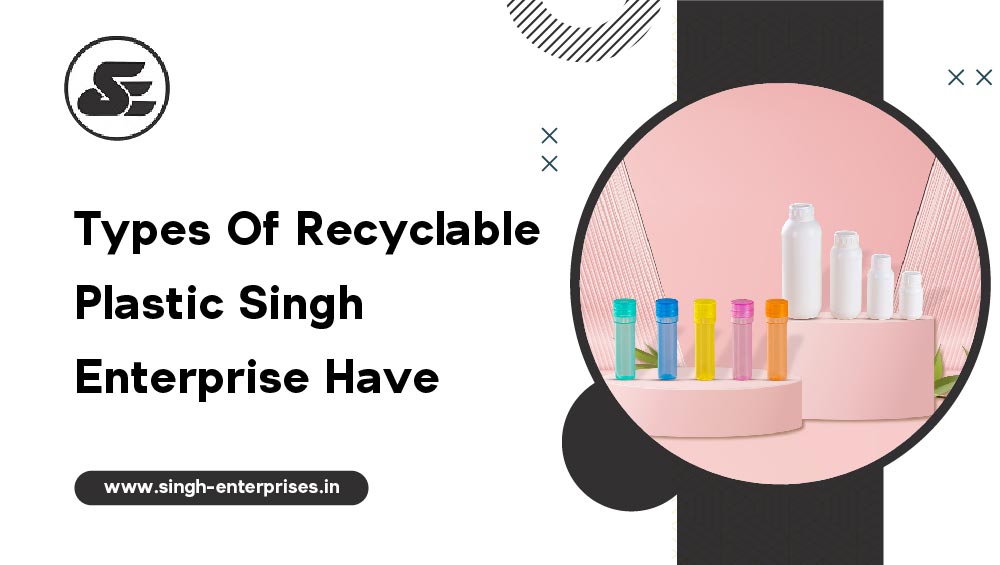Singh Enterprises, a leading plastic packaging supplier and manufacturer, is committed to sustainable practices and providing eco-friendly solutions. As part of their dedication to responsible packaging, Singh Enterprises offers recyclable plastic options for various products, including shampoo bottles, cream containers, chemical containers, and more. In this blog, we will explore two common types of recyclable plastic provided by Singh Enterprises: HDPE (High-Density Polyethylene) and PET (Polyethylene Terephthalate). Let’s delve into their characteristics, recycling processes, environmental benefits, and uses.
HDPE (High-Density Polyethylene):
HDPE is a versatile and widely used type of recyclable plastic. It is known for its strong and durable nature, making it suitable for a range of packaging applications. Singh Enterprises offers HDPE bottles and containers that are ideal for storing liquids, creams, and chemicals. Some key features of HDPE include:
Recyclability: HDPE is highly recyclable and can be processed to create new products, reducing the demand for virgin plastic materials.
Recycling Process: The recycling of HDPE involves collecting, sorting, and cleaning plastic waste. It is then shredded, melted, and molded into new products, such as plastic bottles, pipes, and packaging materials.
Environmental Benefits: Choosing HDPE containers helps reduce the environmental impact of plastic waste. Recycling HDPE saves energy, reduces greenhouse gas emissions, and conserves natural resources compared to the production of new plastic.
In addition to the environmental benefits, there are also economic benefits to recycling HDPE. Recycling HDPE creates jobs in the recycling industry and reduces the cost of waste disposal for businesses and municipalities. It also helps to reduce the cost of producing new plastic products, as recycled HDPE can be cheaper than virgin plastic.
Using recycled HDPE can also benefit consumers. Many companies are starting to use recycled HDPE in their products, which can lead to lower prices and more sustainable options for consumers. Additionally, using recycled HDPE can help to reduce the amount of plastic waste in the environment, which can have positive impacts on wildlife and ecosystems.
It is important to note that while HDPE is highly recyclable, it is still important to reduce the amount of plastic waste being produced in the first place. This can be done by choosing products with less packaging, using reusable containers and bags, and properly disposing of plastic waste to ensure it can be recycled.
Overall, the recycling of HDPE is an important step in reducing the environmental impact of plastic waste. By choosing products made from recycled HDPE and properly disposing of plastic waste, we can all play a role in creating a more sustainable future.
Here are some of the wide uses of HDPE plastic in packaging:
Bottles and containers: HDPE plastic is commonly used to make bottles and containers for various products such as milk, juice, cleaning agents, and personal care products. The material is lightweight, flexible, and can withstand high temperatures, making it ideal for packaging liquids and semi-solid products.
Industrial packaging: HDPE plastic is used in industrial packaging for products such as chemicals, fertilizers, and lubricants. The material can withstand harsh environments and is resistant to chemicals, making it a suitable option for industrial packaging.
Caps and closures: HDPE plastic is used to make caps and closures for bottles and containers. The material is easy to mold and can be made into different shapes and sizes, making it ideal for caps and closures.
Pallets: HDPE plastic is used to make pallets for transporting goods. The material is lightweight and durable, making it easy to handle and transport goods.
HDPE plastic is also commonly used in the construction industry. It is used to make pipes for water supply and drainage systems, as well as for gas pipelines. The material is resistant to corrosion and can withstand high pressure, making it a reliable option for such applications.
Another use of HDPE plastic is in the manufacturing of toys and playground equipment. The material is safe for children to play with and is durable enough to withstand wear and tear. It is also easy to clean, making it a popular choice for parents and childcare providers.
It is also used in the automotive industry for various applications such as fuel tanks, bumpers, and interior parts. The material is lightweight and can withstand impact, making it ideal for such applications.
In the agricultural industry, HDPE plastic is used for irrigation systems, greenhouse coverings, and animal feeders. The material is resistant to UV rays and can withstand harsh weather conditions, making it a reliable option for outdoor applications.
Overall, HDPE plastic is a versatile material that is used in a wide range of applications. Its durability, flexibility, and resistance to harsh environments make it a popular choice for packaging, industrial, construction, automotive, and agricultural applications.
Singh Enterprises, a leading supplier and manufacturer of plastic packaging, offers a range of recyclable plastic options, including HDPE. These types of plastic are highly versatile, durable, and environmentally friendly. By choosing recyclable plastic packaging from Singh Enterprises, businesses, and consumers can actively participate in the circular economy, promoting sustainability and reducing the environmental impact of plastic waste. Together, let’s embrace responsible packaging choices and contribute to a greener future.





